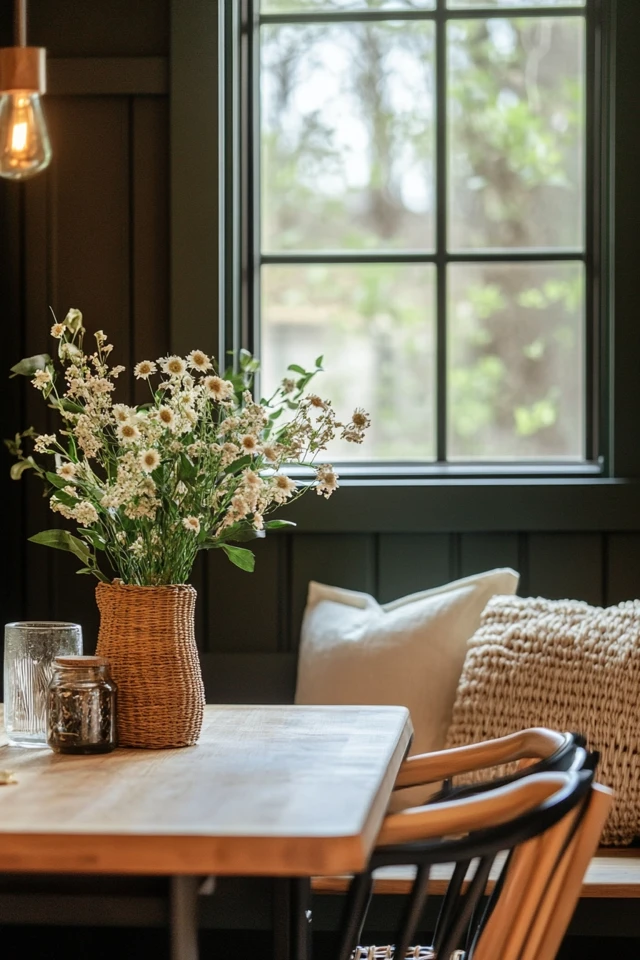Introduction
I’ll never forget the first time I designed a farmhouse dining nook. It was for a cozy little cottage tucked away in the countryside, and the homeowner wanted a space where her family could gather for Sunday breakfasts and late-night card games. There was something so personal about crafting a nook that wasn’t just functional but also warm, welcoming, and brimming with farmhouse charm. That project taught me a lot about how small details—like textured fabrics, layered lighting, and thoughtful furniture—can transform an ordinary corner into the heart of a home.
Farmhouse dining nooks are all about creating spaces that feel inviting. They embody the farmhouse style’s key principles: rustic elegance, practicality, and comfort. Whether you’re working with a sunny corner in your kitchen, a bay window in your dining area, or a compact space in a larger room, you can create a farmhouse nook that serves as the perfect gathering spot.
In this guide, I’ll walk you through how to design a farmhouse dining nook that feels cozy, functional, and beautiful. We’ll explore evidence-based design (EBD) principles, clever space-saving strategies, and styling tips that will make your nook the most inviting spot in your home.
Why Dining Nooks Work So Well in Farmhouse Design
Functionality Meets Warmth
Farmhouse dining nooks are the epitome of practical charm. They make efficient use of small spaces while fostering a sense of intimacy and connection.
EBD Insight: The Psychology of Cozy Spaces
Evidence-based design highlights how smaller, enclosed areas—like nooks—can evoke feelings of safety and comfort. These “nest-like” spaces are perfect for fostering meaningful connections, whether you’re enjoying a family meal or having a quiet moment with a cup of coffee.
Step 1: Choose the Perfect Spot
The location of your dining nook sets the foundation for its functionality and charm.
Ideal Spaces for a Farmhouse Dining Nook
- Bay Windows: Utilize the natural light and scenic views by placing your nook beneath a bay window.
- Kitchen Corners: A corner nook in the kitchen makes it easy to serve meals and keeps the space cozy.
- Unused Alcoves: Transform an underused corner or alcove into a stylish and functional dining area.
Step 2: Select Farmhouse-Friendly Furniture
Furniture is the centerpiece of your farmhouse dining nook. Choose pieces that balance style, comfort, and practicality.
The Essentials:
1. Dining Table
- Style: Opt for a rustic wood table with natural finishes or a distressed look.
- Shape: Round tables work well in smaller nooks, while rectangular tables are ideal for larger spaces.
2. Seating
- Banquette Seating: Built-in benches or banquettes maximize seating and create a cozy, enclosed feel. Add cushions for comfort and a pop of texture.
- Mix-and-Match Chairs: Pair mismatched chairs with a bench for a casual, farmhouse vibe. Consider upholstered chairs for added comfort.
3. Storage-Friendly Furniture
- Look for banquettes or benches with hidden storage to tuck away linens, board games, or extra tableware.
EBD Insight: Ergonomics Matter
Choose furniture that supports good posture and provides adequate cushioning to ensure long-lasting comfort for family meals and gatherings.
Step 3: Layer the Lighting
Lighting plays a critical role in setting the mood for your dining nook.
Farmhouse Lighting Ideas:
- Pendant Lights: Hang a large, rustic pendant light or lantern-style fixture above the table for a statement piece.
- Wall Sconces: Install sconces on either side of the nook to provide soft, ambient lighting.
- Natural Light: Take advantage of windows by keeping treatments minimal or using light-filtering curtains.
EBD Insight: The Impact of Light
Proper lighting enhances functionality and ambiance. Warm, diffused lighting creates a welcoming atmosphere, while task lighting ensures practicality for meals and activities.
Step 4: Incorporate Textures and Textiles
Textures and textiles are essential for creating the cozy, layered look that farmhouse design is known for.
Ideas for Textiles:
- Cushions and Pillows: Add plaid, striped, or linen cushions in neutral tones or soft pastels to banquette seating or chairs.
- Rugs: Place a jute or braided rug under the table to define the space and add warmth.
- Table Linens: Use a farmhouse-style table runner or cloth in natural fabrics like burlap, cotton, or linen.
EBD Insight: Textures Create Comfort
Layering soft and tactile materials can reduce stress and create a calming environment, making your dining nook even more inviting.
Step 5: Add Farmhouse Decor
Decorative accents are the finishing touch that ties your farmhouse dining nook together.
Ideas for Farmhouse Decor:
- Centerpieces: Use a wooden tray to display candles, a vase of fresh flowers, or a bowl of seasonal fruit.
- Wall Decor: Hang rustic artwork, a vintage clock, or a small gallery wall with family photos.
- Greenery: Incorporate potted plants, a hanging herb garden, or faux eucalyptus garlands for a fresh, natural touch.
DIY Tip: Repurpose vintage finds like old crates, mason jars, or enamel pitchers for unique decor that adds character to your nook.
Picture Gallery
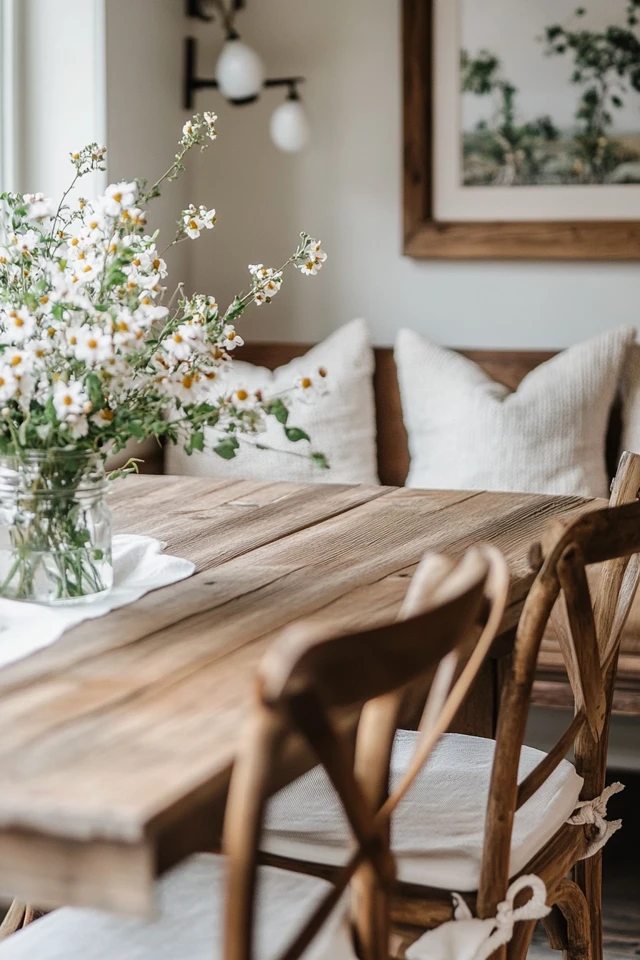
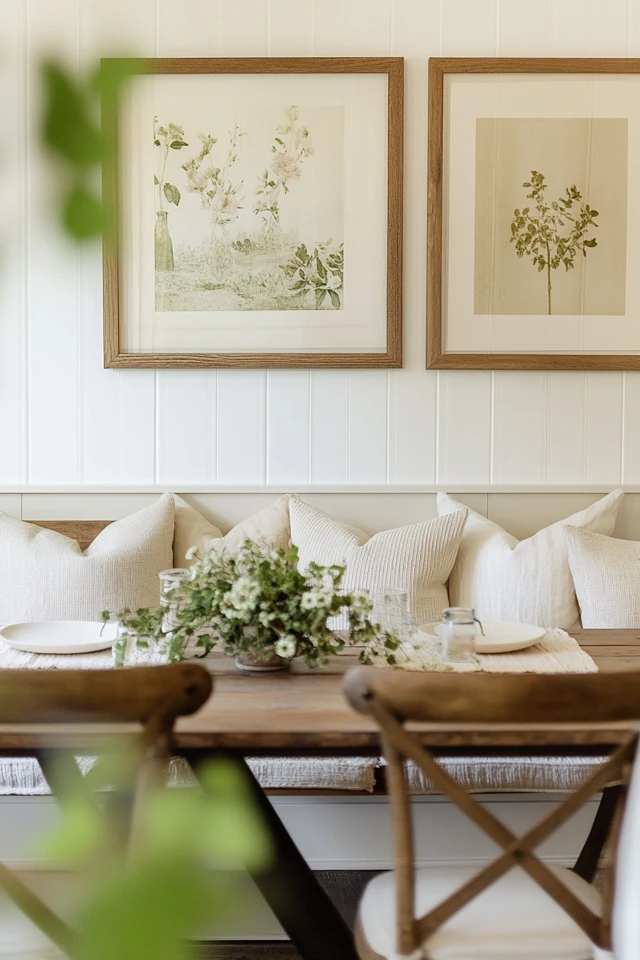
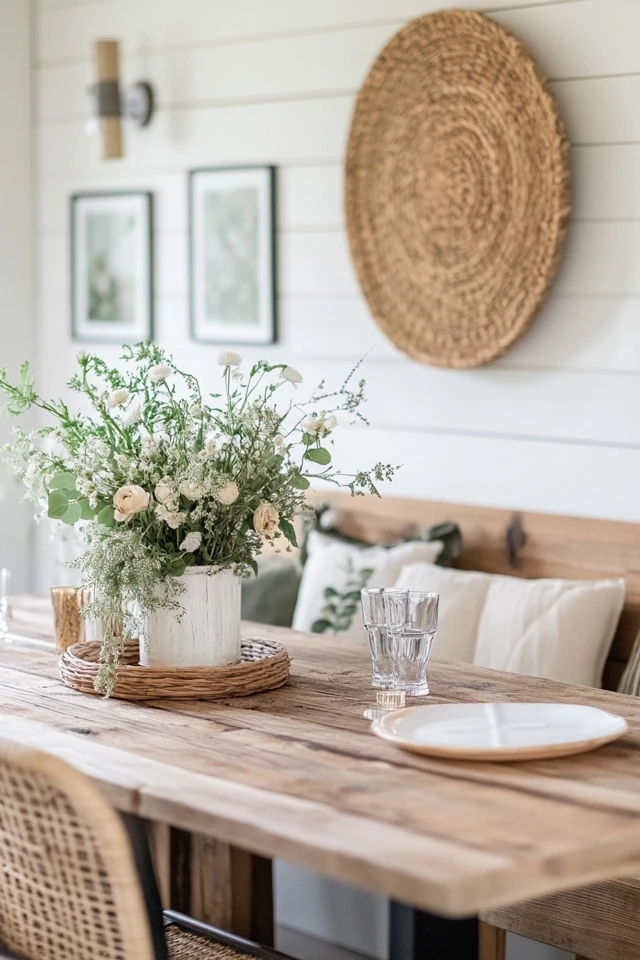
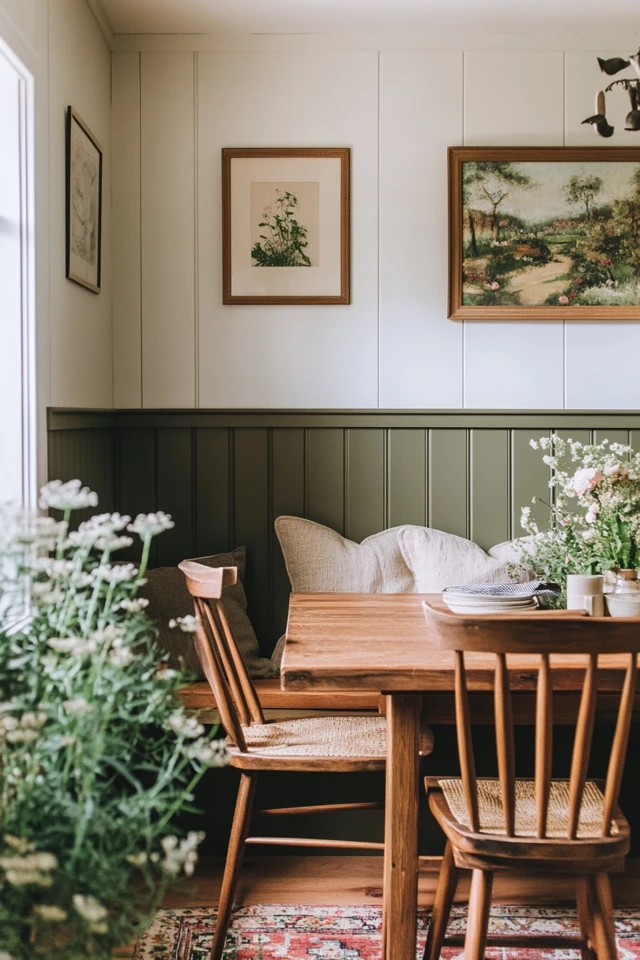
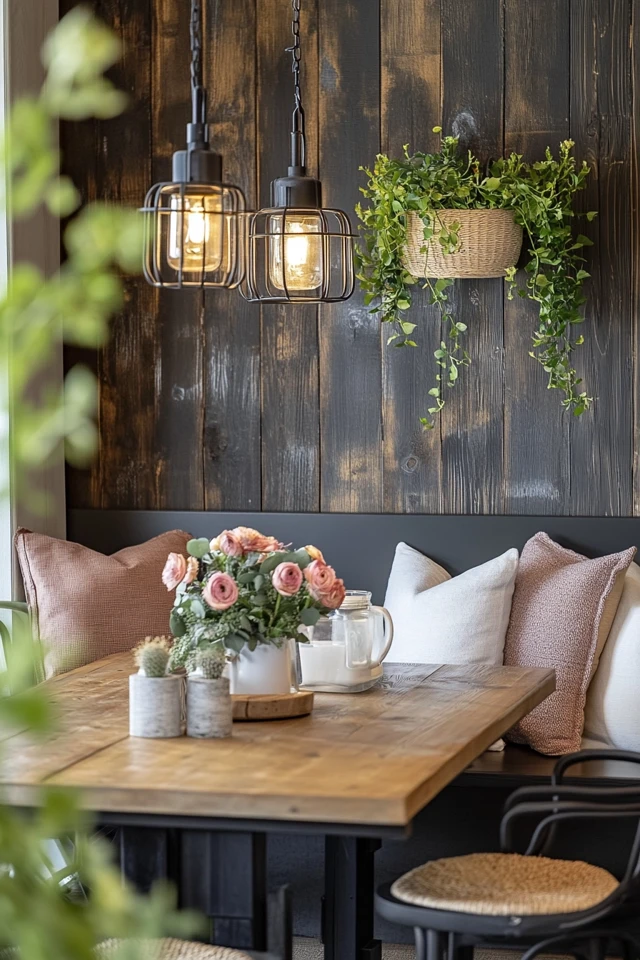
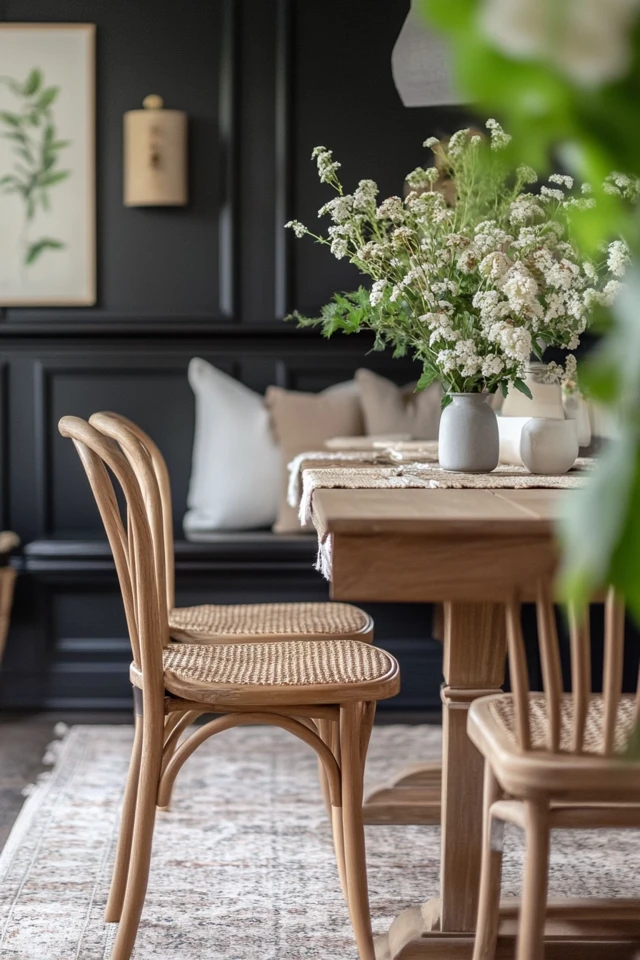
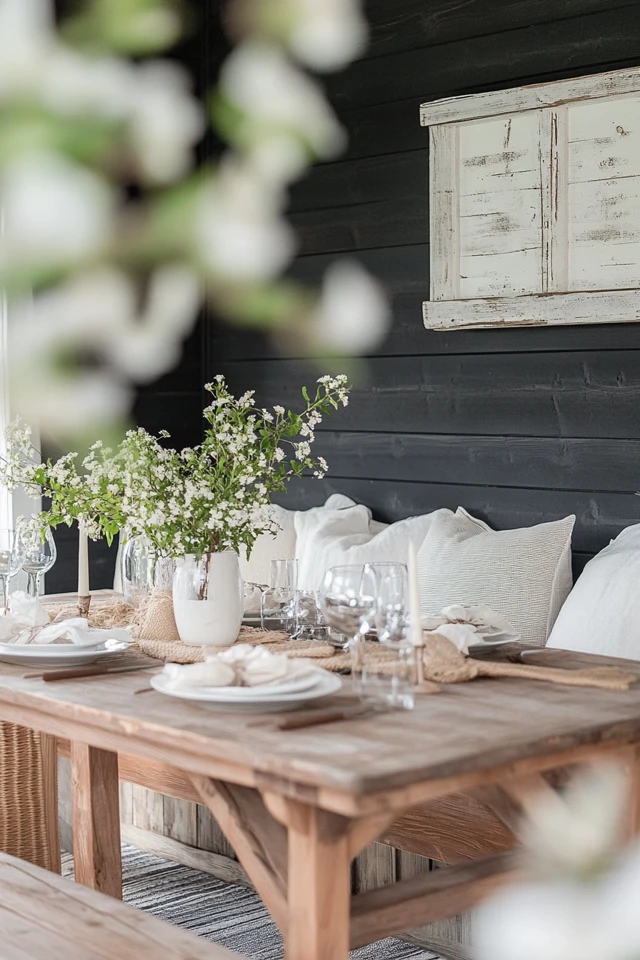
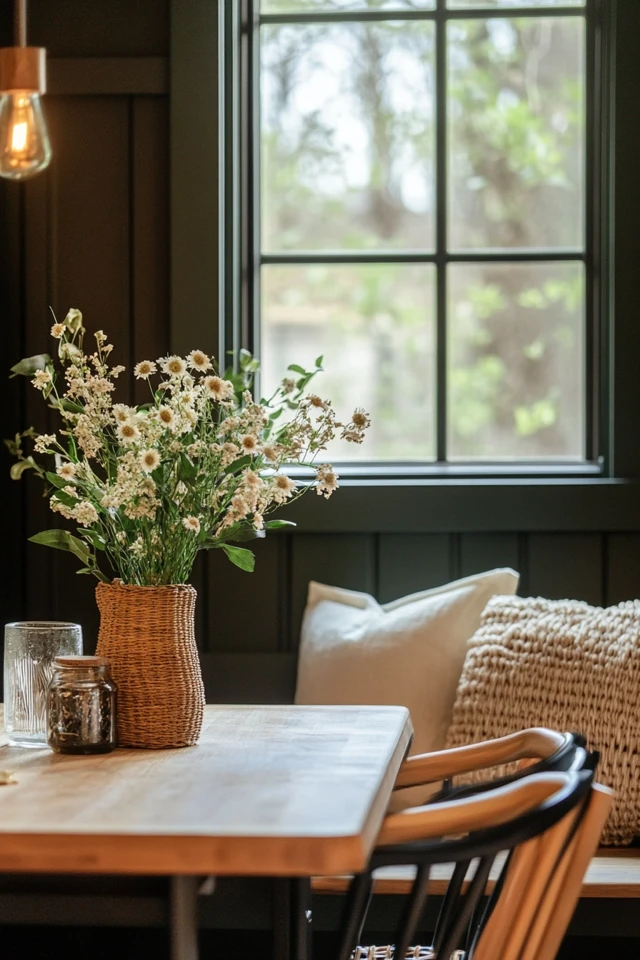
Step 6: Maximize Functionality in Small Spaces
If you’re working with limited space, use clever strategies to make your farmhouse dining nook as functional as possible.
Space-Saving Tips:
- Built-In Shelves: Add shelving above or around your nook for extra storage and display space.
- Foldable Tables: Use a drop-leaf or extendable table to save space when not in use.
- Corner Benches: Fit your seating snugly into corners to make the most of your square footage.
EBD Insight: The Power of Organization
A clutter-free dining nook promotes relaxation and makes the space more enjoyable for daily use.
Step 7: Design for All Seasons
A farmhouse dining nook can evolve with the seasons to keep it feeling fresh and inviting year-round.
Seasonal Styling Ideas:
- Spring: Add pastel cushions, fresh flowers, and floral-patterned table linens.
- Summer: Incorporate greenery, light fabrics, and coastal-inspired accents.
- Fall: Use plaid throws, pumpkins, and earthy tones like burnt orange or mustard yellow.
- Winter: Layer cozy textures like faux fur or chunky knit cushions and add twinkling fairy lights.
Conclusion
A farmhouse dining nook isn’t just a place to eat—it’s a space to gather, connect, and make memories. By focusing on cozy seating, thoughtful lighting, layered textures, and practical design, you can create a nook that feels as warm and inviting as it is functional.
Looking back on the dining nooks I’ve designed, I’m reminded of how these small spaces can have such a big impact. They bring people together, add character to your home, and offer a quiet retreat for moments of solitude. So, whether you’re transforming a sunny kitchen corner or creating a statement in your dining area, I encourage you to pour your personality into the process and make it your own.
Happy designing, and may your farmhouse dining nook become the heart of your home!
FAQ
What type of table works best for a farmhouse dining nook?
A rustic wooden table with a natural or distressed finish is ideal. Choose a round table for smaller spaces or a rectangular table for larger nooks.
How do I make a small dining nook feel larger?
Use light colors, mirrors, and built-in seating to create the illusion of more space. Keep decor minimal to reduce visual clutter.
Can I create a dining nook in a rental home?
Yes! Use freestanding furniture like benches and tables, and add wall decor with damage-free hanging solutions.
What’s the best lighting for a farmhouse dining nook?
Pendant lights or lantern-style fixtures work well for farmhouse design. Pair with natural light and sconces for added warmth.
How do I add seasonal decor to my dining nook?
Swap out cushions, table linens, and centerpieces to reflect the season. For example, use pumpkins and plaid in fall, and fresh flowers and pastels in spring.

